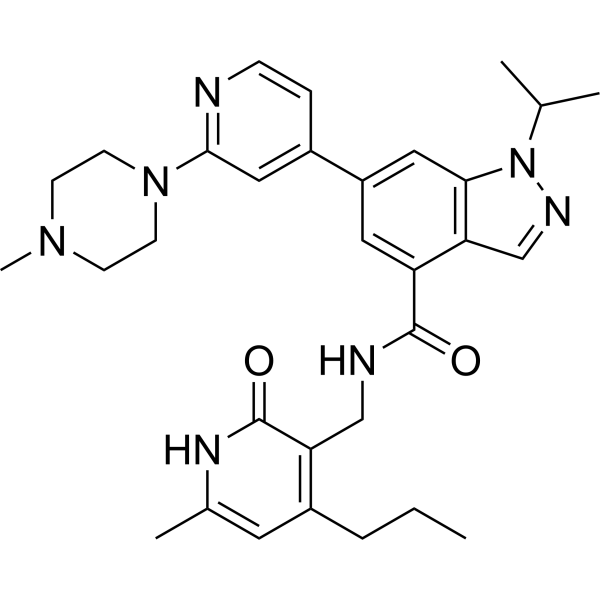Home
Products
GSK343



| Product Name | GSK343 |
| Price: | Inquiry |
| Catalog No.: | CN00278 |
| CAS No.: | 1346704-33-3 |
| Molecular Formula: | C31H39N7O2 |
| Molecular Weight: | 541.69 g/mol |
| Purity: | >=98% |
| Type of Compound: | Alkaloids |
| Physical Desc.: | Powder |
| Source: | |
| Solvent: | Chloroform, Dichloromethane, Ethyl Acetate, DMSO, Acetone, etc. |
| SMILES: | CCCc1cc(C)[nH]c(=O)c1CNC(=O)c1cc(cc2c1cnn2C(C)C)c1ccnc(c1)N1CCN(CC1)C |
| Contact us | |
|---|---|
| First Name: | |
| Last Name: | |
| E-mail: | |
| Question: | |
| Description | GSK343 is a highly potent and selective EZH2 inhibitor with an IC50 of 4 nM. |
| Target | IC50: 4 nM (EZH2), 240 nM (EZH1)[1] |
| In Vitro | GSK343, which contains an n-propyl group at the 4-position of the pyridone, has EZH2 Kiapp=1.2±0.2 nM. In this 6-day proliferation assay, among the cell lines evaluated in this study, the prostate cancer cell line LNCaP is the most sensitive to EZH2 inhibition, with growth IC50 value of 2.9 μM for GSK343[1]. GSK343 is found to have half maximal inhibitory concentration values of 13 μM in HeLa cells and 15 μM in SiHa cells[2]. |
| In Vivo | Compare with the controls, GSK343 (5 mg/kg)-treated mice exhibits significantly inhibited tumor growth. The average tumor volume and weight of the GSK343-treated cohort is remarkably reduced. As early as 20 days post-implantation, a significant reduction in tumor growth is observed in the GSK343-treated cohort relative to the control cohort; this difference persisted through the remainder of the study. In addition, compare with the control cohort, the GSK343-treated animals in the xenograft model show a remarkable increase in messenger RNA levels of E-cadherin but a significant decrease in vimentin messenger RNA levels[2]. |
| Cell Assay | To account for varying doubling rates among cancer cell lines, the optimal cell seeding is determined empirically for all cell lines by examining their growth in a 384-well plate over 6 days with a wide range of seeding densities. Cells are then plated at the optimal seeding density and allowed to adhere overnight. Cells are treated in duplicate with a 20-point 2-fold dilution series of GSK343 or 0.147% DMSO (vehicle control) and incubated for 6 days at 37°C in 5% CO2. Cells are then lysed with 25 μL CellTiter-Glo per well and chemiluminescence is quantified with a TECAN Safire2 microplate reader. In addition, an untreated plate of cells is harvested at the time of GSK343 addition (T0) to quantify the starting number of cells. CTG values after 6 days of treatment are expressed as a percent of the T0 value and plotted against GSK343 concentration. Data are fit with a 4-parameter equation to generate a concentration response curve and the concentration of GSK343 required to inhibit 50% of growth (gIC50) is determined[1]. |
| Animal Admin | Mice[2] Six-week-old female nude BALB/c mice are used. To study the effect of the EZH2 inhibitor GSK343, 5 mg/kg in 100-μL phosphate-buffered saline is injected intraperitoneally every other day into BALB/c nude mice (n=6) after the tumor volume reaches 100 mm3. In this analysis, the negative control group (n=6) received saline. After 40 days, the mice are killed, and the subcutaneous tumors are surgically excised, weighed, photographed, sectioned, and fixed in 10% formalin. The expression levels of E-cadherin, N-cadherin, and vimentin in the tumours are measured by real-time reverse transcription polymerase chain reaction. |
| Density | 1.3±0.1 g/cm3 |
| Boiling Point | 797.4±60.0 °C at 760 mmHg |
| Flash Point | 436.0±32.9 °C |
| Exact Mass | 541.316528 |
| PSA | 99.41000 |
| LogP | 3.22 |
| Vapour Pressure | 0.0±2.8 mmHg at 25°C |
| Storage condition | 2-8°C |